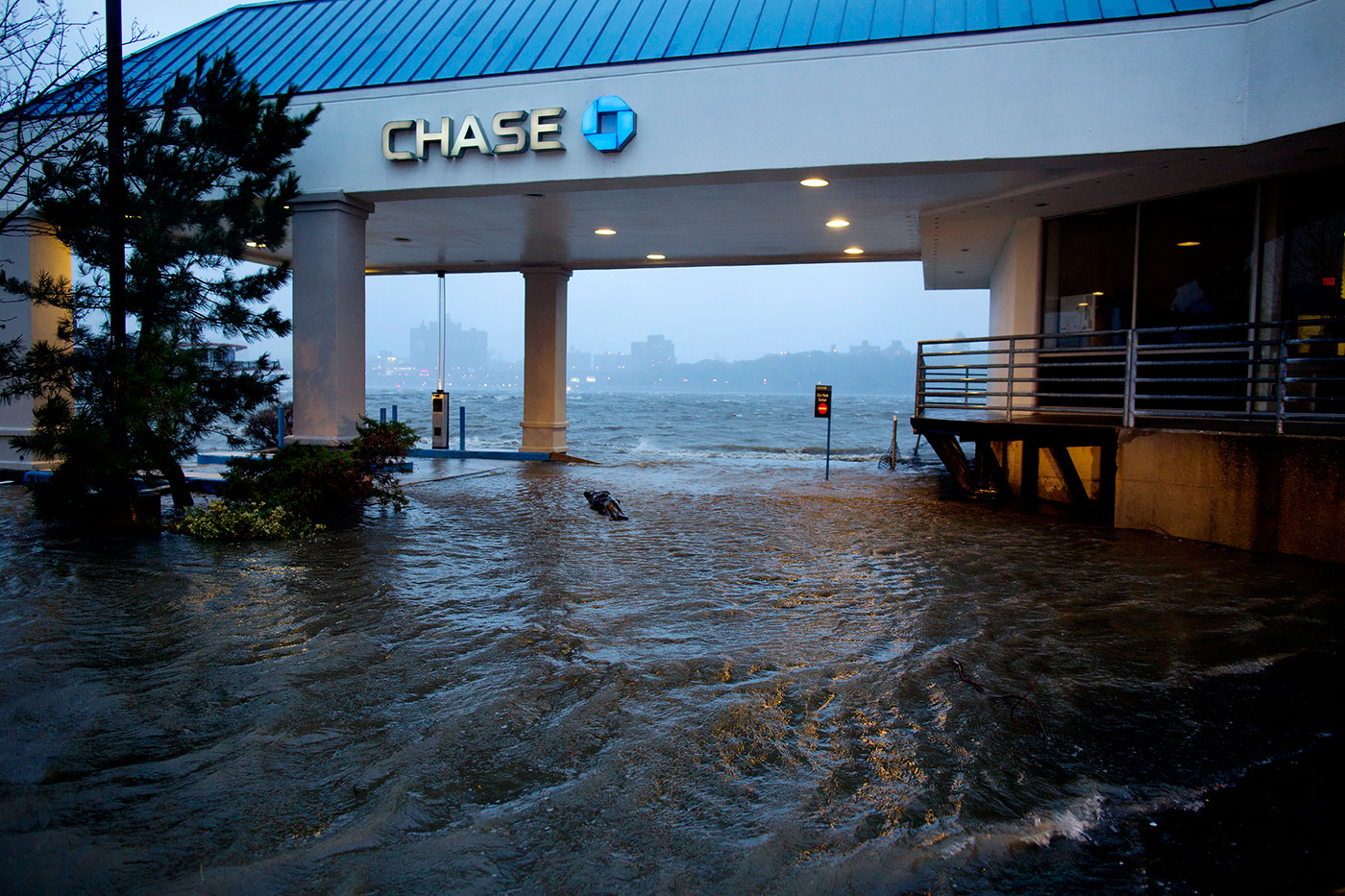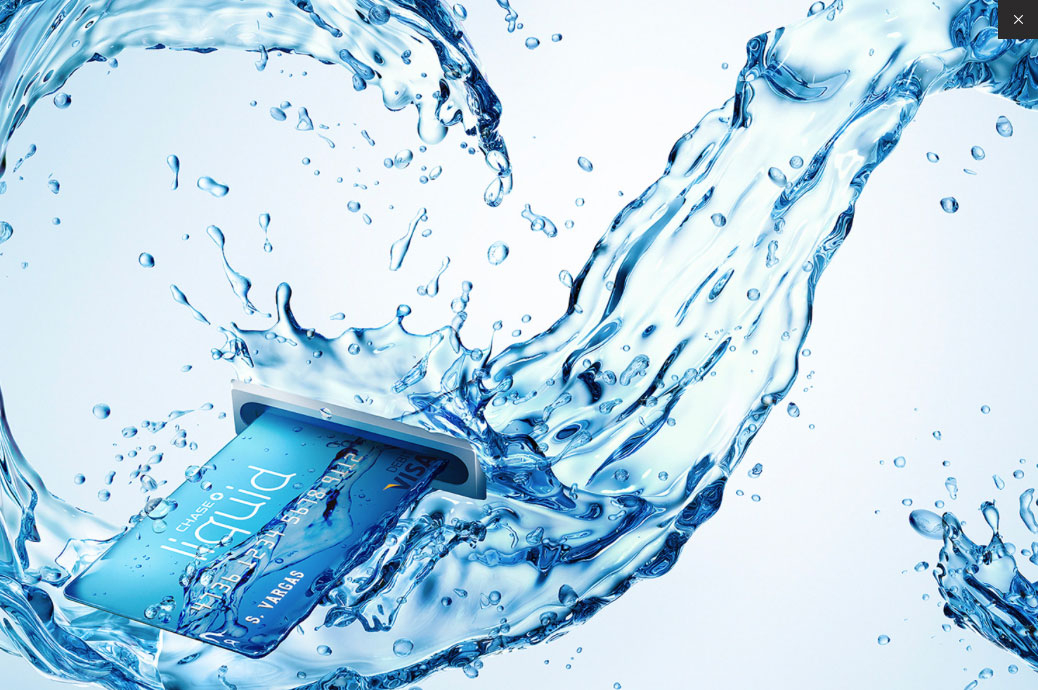It was a big and beautiful wave, with satisfying hues of blue highlighting its crystal clear fluid while little droplets danced around its edges. The wave’s creators had frozen its movement just at the moment it was breaking, its abstract and frictionless surrounding making for a dramatic rendering. They were clearly proud of the outcome. They called it “liquid sculpted to perfection.” How satisfactory it must have felt to control the fluid, its consistency and shapes, its movements and lighting, and to be able to stop it at any chosen frame—a task that would have been impossible to achieve in the real world. I came across the website by coincidence, and learned that the wave was part of the online portfolio of Saddington-Baynes, a production studio in London that specialized in computer renderings for major consumer brands. A project brief explained that the wave had been created for JP Morgan Chase’s new prepaid card Chase Liquid, for which the bank had hired two New York branding companies that had in turn collaborated with Saddington-Baynes to design and animate the campaign’s signature fluid. The agencies had provided mood boards for visual guidance, and the studio’s task had been “to discover a personality of liquid that could best represent the brand."
While Chase never named or identified its liquid, it clearly resembled water, the ubiquitous substance that we all rely upon as a necessity of life. The bank’s branding campaign then established a strong analogy between water and the more abstract concept of financial liquidity, which the computer animators illustrated by letting the water seamlessly morph into the shape of the banking card itself, thus changing its movement from expressive to contained, and its physical state from liquid to solid. I can see how this ‘water-filled’ product could resonate with prospective customers, especially those who might have been more exposed to a financial drought (to keep with the water-based analogy), than to a powerful stream. If someone struggles financially, why wouldn’t s/he like to possess a banking card that seemed to unleash a much-needed cash flow? To further capitalize on the concept of its potent fluid, JP Morgan Chase launched the card’s ads and commercials in the hot summer months, slyly countering the sweltering heat with large-scale displays of Chase Liquid’s cool splashes.
One could easily dismiss the analogy between water and money as banal and the branding campaign as just another exaggerated form of product fiction (i.e. the visual indication of abundance). But what kept me engaged with this card was how the company strategized the water for their underlying business goals. First, let’s take a closer look at the capacities of the card. Chase Liquid’s branding narrative is full of transformations—between materials, states, and realities—but when it comes to its actual functions the card is very straight forward and limited. Prepaid cards, unlike credit cards, don’t offer funds others than what a cardholder, his/her parents, an employer, etc. loads onto them. This concept avoids overdraft and interest fees, but it also serves as a reality-check to the cardholder’s actual means. In a scenario where the cardholder is facing unemployment or stagnant wages, not to mention rising costs of living, s/he might never have a chance to keep money and have it accumulate. As a consequence, the narrative of flow unwittingly shifts from plentiful liquidity to the effect of a relentless flowing by, caused by a strong pull away from the cardholder. The situation looks quite different from the perspective of the bank, for which Chase Liquid functions as an efficient pipeline to collect and channel the customers’ monthly fees and funds into accumulating revenue. According to research by the Mercator Advisory Group, the amount loaded on prepaid cards rose from $5 billion in 2003, to $184 billion in 2011. At that point the branded water’s double nature becomes undeniably transparent: while the customer is presented with a mirage, a projection of a large body of water that isn’t there, the bank’s stockholders are reassured—through the same image, but with different connotation—that a rising number of new customers will guarantee an increase of their profits.
Let’s now return to the idea of sculpting water. When one looks at water performing in a fountain or an artwork, one notices the technical frameworks that enable the water’s shapes and rhythms. For example, take the artist’s Olafur Eliasson’s large-scale waterfalls, whose physical frameworks are as visible and present as the falling water itself, clearly illustrating the technical (and monetary) effort that it takes to sculpt the water in that manner. And while one might not fully understand the specific complexities that orchestrate the liquid’s performance, one can clearly see their dependency on each other. In the case of Chase Liquid, though, the apparatus that created the water’s performance—the simulation software—is no longer visible to its customers. The water’s source cannot be traced except to its code in the program. And now that the liquid’s behavior is no longer dependent on physical laws like gravity and friction, its flow can be sculpted and manipulated in endless ways. And it is on this specific level that I think water and financial liquidity, along with the company and its branding image, come together in a perhaps unintended, but most convincing analogy: as shape-shifting entities with evasive qualities and free-wheeling moves.
In this context, it is worth to go back to 1799, when the bank’s earliest predecessor, the Bank of Manhattan Company, was founded. Historical records show that Aaron Burr, a U.S. senator and future vice president of the United States, was determined to open a bank in New York City. Knowing that the ruling elite and his political opponents would never support this plan, he conceived of an elaborate plot to deceive them. Aware of the city’s struggle with the quality and supply of its drinking water, he set up a water business called Manhattan Company to offer improvement in that matter. Using the vision of clean and free flowing water to his advantage, he secured the city’s commission to build an aqueduct that would pipe in fresh water from the Bronx River to the densely populated area in what is today known as Lower Manhattan. But Burr also made sure that the contract contained a loophole, which would allow him to use surplus from the city’s generous water funds for investments that were unrelated to that commission. He then redistributed a large part of the funds into his new business, the Bank of Manhattan Company, and initiated its services. The aqueduct was never built. Instead Burr’s company put a much cheaper and more local pipe system into place, which had to rely on water holes and tanks, and which, due to its close proximity to the living quarters’ waste dumps, was unfit to truly improve the water’s quantity, quality and circulation. Tensions rose between the city and the company over its handling of the project, and in 1808 the company sold the water works back to the city. When Manhattan Company closed its doors, its second division, the Bank of Manhattan Company, had become a solid business. Half a century and several mergers later, it was incorporated into JP Morgan Chase Bank & Co.
It was a big and powerful stream, muddied by everything it had passed or dragged along during that night, its undiscriminating flow damaging humble residencies as well as luxurious homes. It even took on the Financial District, suspending the New York Stock Exchange’s trading operations. The name given to the storm that had caused the flood made it sound harmless: Sandy. While it was a natural disaster, it could also be seen as a statement, as if the deluge of water was a reality check on the extent that anyone is actually in control. The next day was calmer, with the atmosphere of a snow day mixed with sorrow, and disbelief. Daily routines were disrupted. I was in Brooklyn, walking towards the Barclays Center when a bus passed by with a Chase Liquid ad featured on its side. Reality had just intruded on the fantasy presented by the branding message. But that wouldn’t last long. As soon as the flood waters started to recede, the deep-rooted story of JPMorgan Chase’s life-improving liquid was ready to resurface.







